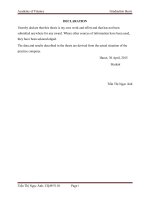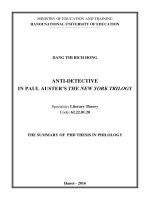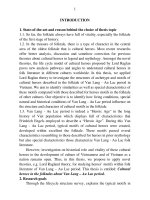[Luận văn bằng tiếng anh - GRADUATION THESIS] “ACCOUNTING FOR SALES AND DETERMINING BUSINESS RESULT AT AMISU SERVICES SUPPLYING COMPANY LIMITED”
Bạn đang xem bản rút gọn của tài liệu. Xem và tải ngay bản đầy đủ của tài liệu tại đây (5.11 MB, 107 trang )
MINISTRY OF FINANCE
ACADEMY OF FINANCE
----------
GRADUATION THESIS
“ACCOUNTING FOR SALES AND DETERMINING BUSINESS
RESULT AT AMISU SERVICES SUPPLYING COMPANY LIMITED”
Major : Corporate Accounting
Mentor : PhD. Thai Ba Cong and
MSc. Nguyen Ba Linh
Hanoi – 2022
DECLARATION
I hereby declare that this thesis is the result of my own efforts. Other sources
of information have been cited when they were utilised.
The data and outcomes presented in the thesis are based on the internship
company's current status.
The subject of this thesis is “Accounting for sales and determining business
result at AMISU Services Supplying Company Limited”.
Ha Noi, January 11th, 2022.
Student
1
ACKNOWLEDGEMENT
To begin with, I'd like to convey my heartfelt gratitude to all of the
Accounting Faculty lecturers at the Academy of Finance for their professional
guidance and invaluable assistance.
I'd like to express my gratitude to my supervisors, PhD. Thai Ba Cong and
MSc.
Nguyen
Ba
Linh,
for
their
patient
guidance,
enthusiastic
encouragement, and helpful critiques during the planning and development of
my Graduation Thesis.
I'd also like to express my gratitude to AMISU Services Supplying Company
Limited for allowing me to begin my thesis in the first place, do the necessary
research, and use departmental data. I also want to express my gratitude to the
Director and Chief Accountant of the Company, as well as all the staffs who
have supported me immensely from the beginning of my internship.
2
TABLE OF CONTENT
Contents
DECLARATION.............................................................................................................................1
ACKNOWLEDGEMENT..............................................................................................................2
TABLE OF CONTENT..................................................................................................................4
PREFACE........................................................................................................................................7
CHAPTER 1: BASIC THEORY OF ACCOUNTING FOR SALES AND DETERMININATION
OF BUSINESS RESULTS IN COMMERCIAL ENTERPRISES...................................................10
1.1. The role of accounting for sales and determining business results in the enterprise.........10
1.1.1. Nature and meaning of sales, determination of business results......................................10
1.1.2. Management requirements for sales, determination of business results....................................11
1.1.3. The necessity and mission of accounting for sales, determining business results...........12
1.1.4. Classifications of sales methods in commercial enterprises..............................................13
1.2. Basic theory of accounting for sales and determination of business results.......................15
1.2.1. Accounting for sales revenue and revenue deductions.....................................................15
1.2.1.3. Accounting for costs of goods sold...................................................................................20
1.2.1.4. Accounting for sellingexpenses and administration expenses.......................................24
1.2.1.5. Accounting for financial incomes and financial expenses..............................................27
1.2.1.6. Accounting for other incomes and other expenses.........................................................30
1.2.1.7. Accounting for corporate income tax expense................................................................33
1.2.1.8. Accounting for determining business results..................................................................35
1.2.1.9.Presenting information about accounting for sales and determination of business
results on financial statements......................................................................................................37
CHAPTER 2: THE ACTUAL ACCOUTING FOR SALES ANDBUSINESS RESULTS AT
AMISU SERVICES SUPPLYING COMPANY LIMITED............................................................42
2.1
OverviewaboutAMISU Services Supplying Company Limited...................................42
2.1.3. Organization and managerial characteristics at the company:.......................................51
2.1.3.1. Chart of the organization and management apparatus.................................................51
2.1.3.2. Benefits from theorganization and management apparatus.........................................53
2.1.4. Theorganizationofaccountingworksinthecompany...........................................................53
2.1.4.1. Accountingapparatusorganizationalcharacteristics......................................................53
2.1.4.2 Accountingpoliciesapplied...............................................................................................55
2.2 Accounting for sales and determining business results at AMISU Services Supplying
Company Limited..........................................................................................................................59
3
2.2.1.
Actual situation of methods of sales and payment at the company............................60
2.2.1.1. Method of sales.................................................................................................................60
2.2.1.2. Method of payment...........................................................................................................60
2.2.2. Accounting for sales revenue and revenue deductions.....................................................60
2.2.3. Accounting for costs of goods sold......................................................................................67
2.2.6. Accounting for other incomes and other expenses............................................................91
2.2.7 Accounting for corporate income tax expense...................................................................92
CHAPTER 3: SOLUTIONS TO IMPROVE ACCOUNTING FOR SALES AND
DETERMINATION OF BUSINESS RESULTS AMISU SERVICES SUPPLYING COMPANY
LIMITED........................................................................................................................................99
3.1. AMISU Services Supplying Company Limited’s development orientation in the
upcoming years..............................................................................................................................99
3.2. Requirements, principles of improving accounting for sales and determining business results
at AMISU Co., LTD......................................................................................................................99
CONCLUSION............................................................................................................................106
REFERENCES............................................................................................................................108
4
PREFACE
1. Urgency of the topic
In the past few years, with limitless efforts of enterprises and the
support of the State and foreign organizations, our country's economy
has made higher and higher development steps, Vietnam's economy has
been increasingly consolidated. However, recently, when the world
economy is in crisis due to the Covid-19 pandemic, our country is not
unaffected. In that circumstance, along with the consequences of
measures to reduce aggregate demand under the tightening monetary
and fiscal policies, it has had a negative impact on the purchasing
power of the market and the economic growth rate. The number of
enterprises shutting down, going bankrupt and being dissolved has
increased rapidly since the end of 2020. Bad debts increased rapidly,
businesses lacked working capital, but banks could not increase credit.
Even with the efforts of the State to encourage business, the economy
entered a new year – 2022 in stagnation, with the growth rate below
potential. Bear that in mind, it is necessary to always have new
business strategies and measures to mobilize and effectively use
resources, exploit market opportunities well, thereby improving
business performance, competitiveness, and increasing the life of
enterprises, especially at time of downs right now.
Any business, whether producing or trading, must be interested in the
consumption of its products, goods and services, because this is the
output of the production process or the trading of the enterprise, which
is recorded in the form of sales revenue after this stage. The existence
and development of an enterprise depends greatly on whether the
enterprise can sell its products or not. Consumption of products
generates revenue, this revenue must offset production costs to make a
profit, which is the foremost and main goal that every business aims
for. It is not only the key to determine growth, but it also determines
the competitiveness of enterprises. Only when the product consumption
is done well, the enterprise has revenue, thus creating the conditions to
reproduce, increasing the accumulation source for the business itself
and for the whole society. In order to manage well and do business
effectively, enterprises must know how to use accounting as an
important and indispensable management tool. Especially to well
5
manage the sales of products and goods, the consumption accounting
work must bring into full play its roles and functions.
To stabilize revenue and business efficiency, managers of every
business need information of the nature of sales management in the
accounting department, as well as to control and organize closely at the
company. Consumption accounting is considered crucial by every
business.
Realizing and bearing in mind the importance of revenue accounting
and determining business results for businesses, I have decided to
choose and do research "Accounting revenue and determining business
results" at AMISU Services Supplying Company Limited – henceforth
called as AMISU Co., LTD to do my graduation thesis.
2. Research purpose
The purposes of this thesis are as follows:
First, synthesize, systemize and apply the knowledge learned about
revenue accounting and determine business results.
Second, analyze the current situation of revenue accounting and
determine business results at AMISU Co., Ltd.
Third, evaluate the advantages and disadvantages, then propose
solutions to improve accounting work in general and revenue
accounting and determine business results at AMISU Co., Ltd.
3. Object and scope of the research
Object: Accounting for sales and determining business results at
AMISU Services Supplying Company Limited
The scope of this research covers the accounting department of AMISU
Co., Ltd.
The data used to analyze the general situation of assets, capital, labor,
and business results of the Company were collected from 2021.
Figures to determine revenue and determine business results are those
of 2021.
4. Research methods
6
a. Data collecting method:
Document research method: Used to collect information related to
the topic from sources such as textbooks, reference books, circulars,
accounting standards, theses... to systemize the basic part. Theory of
revenue accounting and determination of business results.
Direct interview method: This method is used to ask information
and data providers, financial accounting office staff to understand
business activities and accounting work, especially revenue
accounting and business results determination.
b. Data processing method
The accounting method includes the voucher method, the method of
account reciprocity and the method of balance synthesis to serve the
process of researching topics at the company, to systematize and
learn information about the financial transactions arise.
The method of analysis and comparison aims to analyze the
situation of production and business activities as well as find out the
status of revenue accounting and determine business results at the
company, from which to have an overview of the company, thus
proposing measures and recommendations to improve the
accounting work at the company.
5. Thesis structure:
The structure of the thesis "Accounting revenue and determining
business results at AMISU Co., Ltd" is as follows:
Chapter I: Basic theory on accounting for sales and determination of
business results in commercial enterprises
Chapter II: The current situation of accounting for sales and
determination of business results at AMISU Services Supplying
Company Limited
Chapter III: Solutions to improve accounting for sales and
determination of business results at AMISU Services Supplying
Company Limited
7
CHAPTER 1: BASIC THEORY OF ACCOUNTING FOR SALES AND
DETERMININATION OF BUSINESS RESULTS IN COMMERCIAL
ENTERPRISES
1.1. The role of accounting for sales and determining business results in
the enterprise
1.1.1. Nature and meaning of sales, determination of business results
1.1.1.1. Nature of sales and determining business results
Sale is the transfer of ownership of a product or products to customers,
along with the majority of the benefits or hazards, and the customers
make or accept the payment.
The essence of the sales process is the process of buyers and sellers in
the operational market exchanging ownership. External sales are items
sold to individuals and organizations outside the company, whereas
internal sales are goods delivered to units inside the same company or
corporation. Sale is the ultimate stage of a commercial enterprise's
business operation.
The definitions of revenue, cost and business results are as follows:
Revenue: Revenue is the total value of economic benefits earned by the
enterprise in the accounting period, arising from the normal production
and business activities of the enterprise, contributing to the increase of
owners' equity.
Cost: Cost is the total value of the items that reduce economic benefits
in the form of out-of-pocket payments, asset deductions or incurring
debts leading to a decrease in equity, not including distributions to
owners.
Business results: Business results are the final results of the activities
of the enterprise in a certain period, expressed by the difference
between the total revenue and the total cost of economic activities.
1.1.1.2. Meaning of sales activities and determining business result
8
Consumption of commodities is becoming a critical concern for all
commercial organizations in the current trend of economic integration.
As a result, one of the most significant business techniques nowadays is
sales. The increased pace of capital turnover will be aided by quickly
sold goods. The profits are given to the owners, and the workers'
lifestyles are improved while their state obligations are fulfilled.
Furthermore, the sales result is an important financial indicator that
clearly demonstrates the company's operational and financial status.
The determination of business results assists businesses in evaluating
the efficacy of their company activities over time and determining
acceptable future paths. At the same time, it is a crucial foundation for
the State to analyze the ability of companies' business operations,
thereby constructing and analyzing the implementation of their
commitments to the State. Determining business results aids in the
efficient use of human resources and resource allocation for the entire
national economy in general, as well as for each individual business.
1.1.2. Management requirements for sales, determination of business results
Managing the sales process and business results is a must, as it is
funded by the company's profits. If the company controls the sales
stage properly, it will meet its goal of completing the consumption plan
and examine the correctness of the company's production and business
efficiency. As a result, the issues that each firm faces are:
First, Plans and situation management of consumption plans
implementation for each period, each consumer, and each economic
activity.
Second, Quality management and brand building are the aims for
sustainable business development. Manage the quantity, quality, type,
and value of each type of goods in detail to avoid loss, damage, and
embezzlement of finished items for consumption.
Third, Strictly controlling capital, closely monitoring sales expenses,
enterprise management costs, verifying the legality and reasonableness
of data, and allocating to consumer goods, assuring accurate and
acceptable consumption.
Forth, To assure the final determination of the consumption process,
reflect and supervise the complete and timely performance of duties to
9
the State, stringent and scientific organization is required for
consumption accounting.
1.1.3. The necessity and mission of accounting for sales, determining
business results
1.1.3.1. The necessity of accounting for sales, determining business results
Not only for enterprises, but also for the entire national economy, sales
and determining company results are critical. It is possible for the
enterprise to make money to cover costs and enhance working
conditions in order to expand the business, better the lives of
employees, and provide a source of accumulation for the national
economy. The basis for determining the operational efficiency of
enterprises through the payment of taxes, fees, and charges into the
state budget; determining a reasonable costing structure; and highly
effective use of profits earned to harmonize economic benefits is
accurate determination of business results.
Accounting for sales and determining business results is a critical
responsibility for establishing the number and value of sold goods, as
well as the company's turnover and financial results. However, in order
to fully realize the function of well-performing jobs, accounting work
must be organized in a scientific manner, and accountants must have a
clear grasp of the contents of sales accounting and the determination of
business results in companies.
1.1.3.2. The missions of accounting for sales, determining business results
With a view to managing sales and evaluating business result,
accounting for sales and business result has to execute some following
missions below:
Fully, timely, accurately reflecting and recording occurred transactions
and movements of each type of goods and products under quantity,
quality, model and value.
Accurately calculating and reporting results of each transaction.
Monitoring the implementation of state obligations and division
process of business result.
10
Interpreting accounting reports to information users. Accounting
information must be reliable, easy-to-read and useful.
Accounting for sales and determining business result must follow the
accounting standards and able to adapt to the status of the company’s
accounting system.
1.1.4. Classifications of sales methods in commercial enterprises
1.1.4.1. Methods of sales and payment in the enterprises
1.1.4.1.2. Methods of sales
Sales are the activity or business of selling products or services to
customers. There are two typical methods of sales, including direct
sales and sales through agents (consignment sales).
Direct sales: Direct sale refers to selling goods directly to the customers
in a non-retail environment. This method includes wholesale and retail.
Wholesale: is the method of distributing goods to specific customer
types such as domestic or foreign or join-venture manufacturers,
traders, or even private enterprises. Wholesale often occurs when large
quantities of goods are purchased. Due to the volume of the purchase,
the price of the goods is often lower than the price offered to retail
customers. Wholesale usually has two forms: (1) Wholesale from
warehouse & (2) Direct shipping wholesale
Retail: is the method of distributing goods directly to the final
customers, not for resale, but for use and consumption by the
purchaser. In this method, the quantity of goods is small and the price
of the goods is stable. Retail often applies the following forms: (1)
Collective encashment, (2) Direct encashment, (3) Installment
payment, (4) Automatic vending & (5) Goods in transit.
Sales through agents (consignment sales): It is the method of
distributing goods through the channel of agents. The company only
records sales revenue when the agent reports to sell goods. When goods
sold, the company must pay commissions for the agent, which
considered as a selling expense. Sales of goods on consignment for
agents is recorded as sales revenue only when:
- The company has received money payment from the customers.
- The customer has received goods and agreed to pay.
11
- The customer has advanced the amount of purchase payment of
goods.
- The goods on consignment is paid via bank.
1.2.1.4.2. Methods of payment
A payment is the transfer of one form of good, service or financial asset
in exchange for another form of good, service or financial asset in
proportions that have been previously agreed upon by all parties
involved. Payment can be made in the form of funds, assets or services.
There are 2 main payment methods:
Cash payment: Cash payment is a form of payment that, after selling
goods, the buyer makes a payment - immediately pays the seller.
Non-cash payment:
Payment via bank: According to Clause 10, Article 1 of Circular
26/2015/TT-BTC amending and supplementing Clause 3, Article 15 of
Circular 219/2013/ TT-BTC has the following provisions regarding
via-bank payment documents:
- Bank transfer voucher is a transaction document to prove the money
transfer between the buyer and the seller
- Account used for transactions between two parties must be
registered or notified to the tax authorities.
- Can the two parties transfer or transfer money to the private
enterprise owner's personal account if that account is registered with
the tax authorities.
Other non-cash payments:According to Clause 10 Article 1 of Circular
26/2015/TT-BTC amending and supplementing Clause 4 Article 15 of
Circular 219/2013/TT-BTC regulating other cases of non-cash
payments including payment cases as follows: The two parties
implement the method of clearing the value between purchased goods
and services with the value of sold or borrowed goods or services.
Accounting for sales revenue and revenue deductions.
Sales revenue is the amount realized from selling goods in the normal
operations of a company in a specified period.
Net sales is determined by sales revenue after deducting sales
deductions including trade discounts, cash (or settlement) discounts,
and sales returns.
12
1.2. Basic theory of accounting for sales and determination of business
results
1.2.1. Accounting for sales revenue and revenue deductions
1.2.1.1. Accounting for sales revenue
Definition:
Sales revenue is the amount realized from selling goods in the normal
operations of a company in a specified period.
Net sales is determined by sales revenue after deducting sales
deductions including trade discounts, cash (or settlement) discounts,
and sales returns.
Revenue recognition:
According to the VAS 14, sales from sale of goods will be determined only
when it satisfies the following five (5) conditions:
-
The enterprise has transferred the major of risks and benefits associated
with the right to own the products or goods to the buyer.
The enterprise no longer holds the right to manage the goods as the
goods owner, or the right to control the goods.
Turnover has been determined with relative certainty.
The enterprise has gained or will gain economic benefits from the good
sale transaction.
Determining costs related to sales transactions.
Accounting vouchers, documents used
-
VAT invoice
Receipt voucher
Contracts and related documents
Debit note, Request for payment
Credit notes, bank statements and other similar documents.
Accounting accounts used
Account 511: Revenue from sales of goods and services
-
Account 5111: Revenue from sales of goods
13
-
Account 5112: Revenue from sales of finished goods
Account 5113: Revenue from service provisions
Account 5118: Other revenue
Account 3331: Payable VAT
Account 3387: Unrealized revenue
Other related accounts
Accounting entry
Flowchart 1.1 – Accounting entry for direct sales (for company applying
deductible/subtraction VAT method)
Acc 511
Acc 111,112,131
Price without VAT
Total price with VAT
Acc 3331
VAT payable
14
Flowchart 1.2 – Accounting entry for direct sales (for company applying
direct VAT method)
Acc 3331
Acc 511
VAT payable
Acc 111,112,131
Total price with VAT
Flowchart 1.3 – Accounting entry for sales through agents
Acc 511
Acc 111,112,131
Price without VAT
Acc 6421
Commissions for agents
Acc 133
Acc 3331
OutputVATVAT ofcommissions
15
Flowchart 1.4 – Accounting entry for sales in case of deferred or instalment
payment
Acc 511
Acc 111,112,131
Price without VAT
Total price with VAT
Acc 3331
VAT payable
1.2.1.2. Accounting for revenue deductions
Definition
Sales deductions are used to reflect the set of discounted money for shoppers
to be deducted from the business's operating revenue.
According to Circular 133, the revenue deductions are recorded directly to
account 511
Accounting vouchers, documents used
-
VAT invoice
Receipt voucher, payment voucher
Other related documents
Accounting accounts used
Account 511
Accounting entry
16
Flowchart 1.5 – Accounting entry for Revenue deductions
Acc 111,112,131
Acc 511
Revenuedeductions are incurred
Acc 333
Reduction of payable tax
17
1.2.1.3. Accounting for costs of goods sold
Definition
In an enterprise, cost of goods sold is commonly determined as follows:
For goods out of stock for sale, the original value of exported goods is the
cost of goods sold.
The purchased goods are not brought into the warehouse for immediate sale,
the purchase price and the purchase cost are the cost of goods sold.
Method of determining the cost of goods out of stock:
First in first out (FIFO) method
First In, First Out (FIFO) is an accounting method in which assets purchased
or acquired first are disposed of first. FIFO assumes that the remaining
inventory consists of items purchased last.
Weighted average method
The average cost method assigns a cost to inventory items based on the total
cost of goods purchased or produced in a period divided by the total number
of items purchased or produced. The average cost method is also known as
the weighted-average method.
Specific identification method:
The specific identification inventory valuation method is used to track each
purchase and its price individually.
When used for inventory management, it provides more useful information
on sales.
When used for tracking investments, it can reduce capital gains taxes due.
The steps to calculate the cost of goods sold
Calculate the total actual purchase value of goods for sale
Weighted average method:
Average method for the whole reserve period:
18
Actual inventory
Value of goods
+
value
during the period
Actual
average
=
unit price
Actual out-of-stock
value
Actual inventory
=
+
purchased
Quantity purchased during the
period
Quantity of exported
goods
x
Actual
avarage
unit price
The continuous weighted average method:
This method is basically the same as the above method, but the average unit
price is determined on the basis of the actual purchase price in stock at the
beginning of the period and the unit price of each goods import in the period.
Actual value of the
out-of-stock
=
Quantity of exported
goods
x
Unit
price
of
avarage exported
First in first out method: This method assumes that goods that come first will
be out first.
Expenses for purchase and distribution of expenses for out-of-stock goods
At the end of the period, the accountant shall amortize purchasing expense to
the sold out-of-stock goods by the following formula:
Purchase
Purchase expenses
Purchase
Standard
=
+
x
expenses are
from the beginning
expenses incurred
distribution
19









